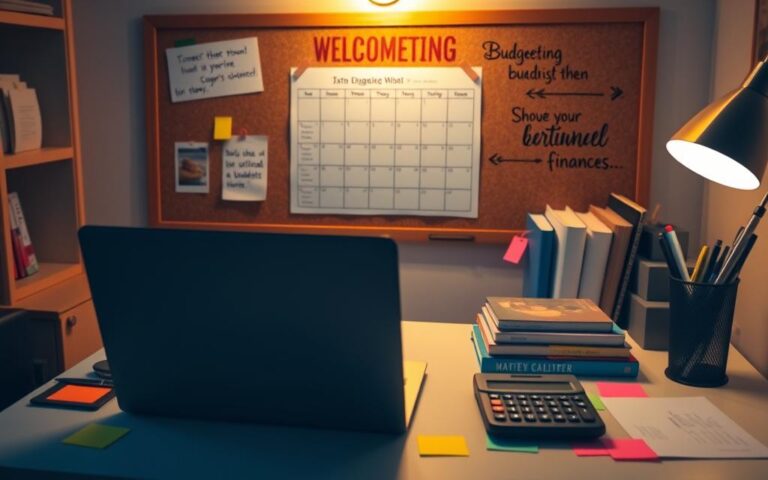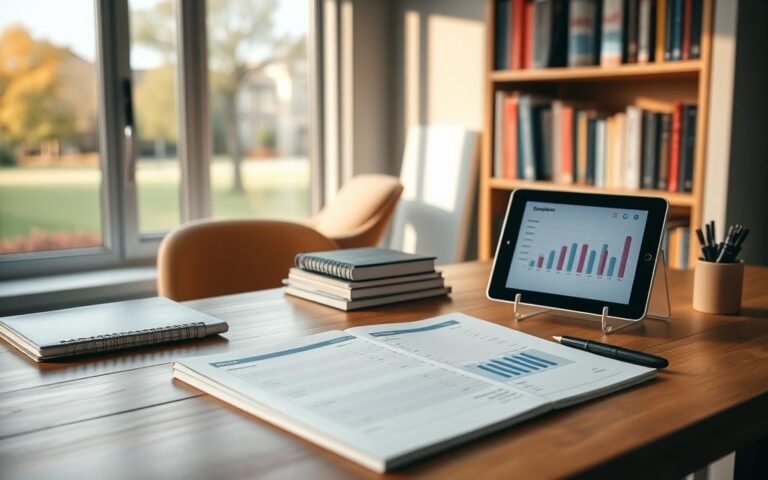Advertisement
Did you know nearly 60% of Americans can’t cover a $1,000 emergency with savings? This fact shows how vital it is to be financially ready. In our unpredictable world, an emergency fund is key to staying stable when facing sudden issues like medical emergencies, car repairs, or losing a job. This guide will show you the importance of emergency savings. We’ll also give you step-by-step tips on building an emergency fund to protect your financial future.
What is an Emergency Fund?
An emergency fund is your financial backup for unexpected events. It’s vital to know what this fund is before we talk about its perks. This fund is cash saved for unplanned needs like medical bills, car fixes, or losing your job.
Definition and Purpose
An emergency fund’s main goal is to keep you financially safe when life gets unpredictable. With money saved, you don’t have to borrow and get into debt when surprises hit. The benefits include feeling secure, less worry about money, and dealing with surprises easily. By making this fund, you protect yourself from the big issues that unplanned expenses can cause.
Importance of an Emergency Fund
Having an emergency fund is super important. Research shows many people can’t handle small emergencies because they don’t save enough. If you don’t have savings, you might use costly credit options, creating long-term money problems. A good emergency fund can make your financial life much stronger and give you stability.

Why You Need an Emergency Fund
Creating an emergency fund is key for staying financially safe during sudden, unexpected events. Without enough money saved, people can be hit hard by surprises like medical bills or household repairs. This fund is like a safety net, giving you peace of mind for those just-in-case moments.
Financial Security During Unexpected Events
Life can throw financial challenges at us without warning. Being unprepared for these surprises can leave us exposed. An emergency fund helps handle these tough times without shaking up your financial foundation.
Avoiding Debt and Financial Strain
Using credit cards or loans in a crisis can trap you in debt. Emergency savings help you deal with these situations without the stress of debt. This means you can pay for what you need without dealing with high interest and fees. It’s a smart move to avoid future financial problems.

| Emergency Fund Advantages | Consequences of No Emergency Fund |
|---|---|
| Provides financial security | Increased stress during emergencies |
| Avoids reliance on debt | Heightened financial strain |
| Ensures quick response to unexpected costs | Potential long-term financial hardship |
How Much Should You Save?
Finding the right amount for an emergency fund needs careful thinking about your situation. Experts say to save enough to cover living expenses for three to six months. This amount varies for everyone, depending on family size, how much money they make, and how stable their job is.
Recommended Savings Amounts
People often start with saving at least $2,000 for urgent situations. But for some, covering half a month’s expenses might be a better initial goal, depending on their personal financial situation. Calculating your emergency fund should include your everyday expenses and other costs that might change.
Factors Influencing Your Target
Many factors determine how much you should save for emergencies. Key factors include your personal expenses, which show how much money you might need for an emergency. The size of your family matters too, as having more people to care for increases your financial risk. Your job’s stability and possible changes in income also play a big part in setting your saving goal, making it important to customize your saving strategy.
Creating a Budget to Save
Starting to save for an emergency fund means being smart with your money. First, look closely at your monthly spending to tell important costs from extras. Knowing this helps you save money for tough times by making smart budget choices.
Analyze Your Monthly Expenses
Keep track of every dollar you spend for a month. Split your spending into needs, like rent and food, and wants, like movies and eating out. This step helps you see where your money goes and find ways to spend less.
Identify Areas to Cut Back
With a good understanding of your spending, look for ways to cut costs. Think about canceling unused memberships, eating in more, or buying generic brands. Small savings in these areas can boost your emergency fund.
Choosing the Right Account for Your Fund
When you’re picking the right account for your emergency fund, think about safety and growth. High-yield savings accounts and money market accounts are great options. They offer benefits for both your current and future money needs.
High-Yield Savings Accounts
High-yield savings accounts give much higher interest rates than regular savings accounts. This makes them a good place to keep your emergency fund. They let you get to your money fast and still earn good interest, growing your savings over time.
Money Market Accounts
Money market accounts are also smart picks for an emergency fund. They mix features from savings and checking accounts. With good interest rates and sometimes even check-writing options, they offer flexible access to your money. This means you can use your money when emergencies happen and still earn interest.
| Account Type | Interest Rate | Withdrawal Options | Minimum Balance Requirement |
|---|---|---|---|
| High-Yield Savings Account | Up to 4.00% | Easy online transfers | Varies (often no minimum) |
| Money Market Account | Up to 3.50% | Check writing, debit card | Varies (often $1,000 or more) |
Setting Up Automatic Transfers
Setting up automatic transfers is key for building a backup fund. It makes saving regularly easier. By setting up these transfers, you don’t have to remember to add to your emergency fund. Over time, your fund will grow, making your financial future more secure.
The Importance of Consistency
It’s important to save money regularly for good financial health. Automatic transfers remove the need to decide to save every month. They make saving simpler and help you stick to your goals. With each transfer, you’re building your financial safety net effortlessly.
How to Automate Your Savings
To start saving automatically, decide how much money you can set aside regularly. Most banks have online tools to help set up recurring transfers. Using these tools makes managing your finances easier. Each deposit grows your emergency fund, strengthening your financial future.
Tips for Increasing Your Savings Rate
Getting more into savings takes clever thinking and planning. You can grow your emergency fund by taking on extra work and using any extra money you get, like bonuses.
Side Gigs and Extra Income
Side jobs are a great way to up your savings while still earning your main paycheck. You could do freelance work, a part-time job, or make money from a hobby. This extra money can help cover your usual expenses. Then, you can save more easily.
Seasonal Windfalls or Bonuses
Seasonal bonuses can also boost your savings. This could be tax returns, holiday bonuses, or other extra earnings. Putting these larger amounts into your savings can strengthen your financial security. It helps you be ready for unplanned costs.
Tracking Your Progress
It’s important to keep an eye on your savings to reach your money goals. Using good budgeting tools makes this easier. Apps like Mint and YNAB help you manage your money better and set clear savings goals. These tools help you organize your money and better understand how you spend. This is key for achieving your emergency fund goals.
Tools and Apps for Budgeting
There are many budgeting tools out there to help you handle your money better. Some well-known options include:
- Mint – Offers expense tracking and budgeting features.
- YNAB – Focuses on proactive budgeting to allocate funds effectively.
- EveryDollar – Simplifies the budgeting process with an easy-to-use interface.
- Personal Capital – Combines budgeting with investment tracking capabilities.
Each tool lets you set budgets, track your savings, and stay on course towards your financial goals. By using these tools regularly, you’ll keep on track with your emergency fund goals.
Establishing Milestones
Creating specific savings milestones helps keep you motivated. Divide your big goals into smaller, achievable milestones to celebrate your progress. Here are some strategies for setting those milestones:
- Determine short-term and long-term savings milestones based on your overall emergency fund target.
- Create a visual representation of your milestones, like a chart or a savings tracker app.
- Reward yourself when you reach a milestone, boosting your saving commitment.
Reaching these milestones makes you feel accomplished and promotes good money habits. As you move forward, take time to appreciate the growth of your emergency fund. This builds a strong financial future.
When to Use Your Emergency Fund
Knowing when to use your emergency fund is key to keeping your finances stable in surprises. It’s important to know what counts as an emergency to make smart choices on taking money out. Big medical costs, needing quick home fixes, or losing your job suddenly are real emergencies. They require fast money action, different from just wanting to spend.
Defining True Emergencies
Real emergencies happen without warning and affect your life or money deeply. Examples include:
- Large medical expenses from accidents or serious sickness.
- Urgent house fixes, like fixing a broken heater or stopping a roof from leaking.
- Not having work suddenly, making it hard to pay for things you really need.
Knowing these cases helps you decide when to use your emergency fund safely, without harming your future money plans.
How to Replenish Your Fund After Use
After you use some of your emergency cash, it’s vital to fill it up again. Start adding money back right away. Ways to do this include:
- Putting away some of your earnings every month into your emergency pot.
- Lowering spending elsewhere so you can save more for emergencies.
- Using extra cash like bonuses or money from extra jobs to refill faster.
Following a strict plan to get your emergency fund back to full strength makes sure you’re ready for anything later.
Common Mistakes to Avoid
Having an emergency fund is vital for a secure financial future. However, many people slip up in ways that weaken their safety net. By knowing these common errors, one can create a truly solid emergency fund.
Underestimating Your Needs
A huge mistake is not saving enough for a crisis. Many don’t think about every expense they might face. This can leave their savings too small.
It’s important to think about all costs, not just the monthly bills. Unexpected things like doctor visits or fixing your home need to be included. Thinking ahead about these things can prevent being caught off guard.
Impulsive Withdrawals
Many people also mess up by taking money out of their emergency fund too soon. This action lowers the fund’s value and defeats its purpose. It’s there for real emergencies, after all.
Being strict about when to use this money is key. It ensures the fund stays ready for big emergencies. Setting firm rules about using the fund helps avoid rash decisions.
Being aware of these errors can make your emergency fund stronger. Planning how much you need and being careful about withdrawals will make your fund more reliable when you really need it.
Conclusion and Next Steps
Creating an emergency fund is crucial for financial stability, not just a one-time deal. By saving regularly, you can have a strong safety net for surprise events. It’s about saving consistently, not just the saved amount.
Setting up automatic money transfers helps you save without thinking about it. This way, you’re always ready for unexpected expenses.
An emergency fund gives you more than just cash; it offers peace of mind during tough times. It prevents you from using high-interest credit that can lead to debt. Your emergency fund is the base for a stable financial future.
So, start building your emergency savings now. The steps you take today will help you during hard times and bring lasting calm. Putting effort into your emergency fund is caring for your present and future.



